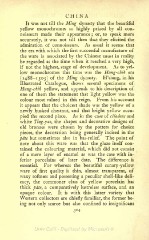Page 374 - Oriental Series Japan and China, Brinkly
P. 374
CHINA
It was not till the Ming dynasty that the beautiful
yellow monochromes so highly prized by all con-
noisseurs made their appearance ; or, to speak more
accurately, it was not till then that they elicited the
admiration of connoisseurs. As usual it seems that
the era with which the first successful manufacture of
the ware is associated by the Chinese must in reality
be regarded as the time when it reached a very high,
if not the highest, stage of development. As to yel-
low monochromes this time was the Hung-chih era
(14881505) of the Ming dynasty. H'siang, in his
Illustrated Catalogue, shows several specimens of
Hung-chih yellow, and appends to his description of
one of them the statement that light yellow was the
colour most valued in this reign. From his account
it appears that the choicest shade was the yellow of a
newly husked chestnut, and that bright yellow occu-
pied the second place. As in the case of celadons and
white Ting-yaOj the shapes and decorative designs of
old bronzes were chosen by the potters for choice
pieces, the decoration being generally incised in the
pate but sometimes also in bas-relief. The point of
note about this ware was that the glaze itself con-
tained the colouring material, which did not consist
of a mere layer of enamel as was the case with in-
ferior porcelains of later date. The difference is
essential. For whereas the beautiful canary-yellow
ware of first quality is thin, almost transparent, of
waxy softness and possessing a peculiar shell-like deli-
cacy, the commoner class of yellow porcelain has
thick pate, a comparatively lustreless surface, and an
opaque colour. It is with this latter variety that
Western collectors are chiefly familiar, the former be-
ing not only scarce but also confined to insignificant
304

